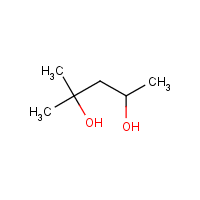Hexylene glycol
Agent Name
Hexylene glycol
CAS Number
107-41-5
Formula
C6-H14-O2
Major Category
Other Classes

Synonyms
(+-)-2-Methyl-2,4-pentanediol; 1,1,3-Trimethyltrimethylenediol; 2,4-Dihydroxy-2-methylpentane; 2,4-Pentanediol, 2-methyl-; 2-Methyl pentane-2,4-diol; 2-Methyl-2,4-pentanediol; 4-Methyl-2,4-pentanediol; Diolane; Hexylene glycol; Isol; Pinakon; alpha,alpha,alpha'-Trimethyltrimethylene glycol; [ChemIDplus]
Category
Alcohols and Polyols, Other
Description
Colorless liquid with a mild, sweetish odor; [NIOSH]
Sources/Uses
Used as a solvent plasticizer in paints and lacquers; Also used in the chemical, petroleum refining, and cosmetic industries and as an additive to hydraulic fluids, inks, cement, leather, paper, and textiles; [ACGIH]
Comments
At 1000 ppm for 5 minutes, human subjects complain of eye, throat, and respiratory irritation. Oral dosing causes central nervous system depression in experimental animals. "Limited animal and human data suggesting a potential for skin sensitization were insufficient to support a DSEN notation." [ACGIH] Allergic contact dermatitis may occur; [Reference #1] A skin, eye, and respiratory tract irritant; [ICSC]
Reference Link #1
Biomedical References
Exposure Assessment
Skin Designation (ACGIH)
Insufficient data
TLV (ACGIH)
25 ppm, vapor fraction
STEL (ACGIH)
50 ppm, vapor fraction (10 mg/m3, inhalable particulate matter, aerosol only)
MAK
10 ppm
Vapor Pressure
0.07 mm Hg
Odor Threshold Low
3.93 ppm
Lethal Concentration
LC50 (rat) > 310 mg/m3/1h
Explanatory Notes
Flash point = 93 deg C, closed cup; Odor threshold of 3.93 reported; [ACGIH] VP from HSDB;
Reference Link #2
NFPA
must be preheated
Adverse Effects
Skin Sensitizer
Yes
Neurotoxin
Acute solvent syndrome
Diseases, Processes, and Activities Linked to This Agent
Diseases
Occupational diseases associated with exposure to this agent:
Processes
Industrial Processes with risk of exposure: